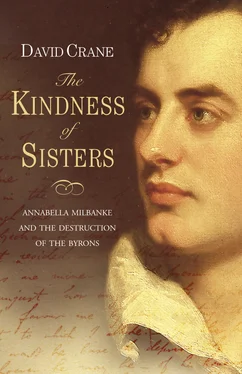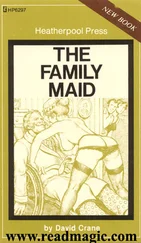On a chill and blustery Tuesday in April 1851, an elderly woman, accompanied by a man in his early thirties, emerged from the entrance at the top of Trafalgar Street in Brighton to take the north-bound railway for Reigate. If anyone in the crowded terminus had noticed either of them it would almost certainly have been the man, a tall and striking figure, whose charismatic preaching at the Holy Trinity had made the names of ‘Brighton’ and ‘Robertson’ synonymous across the English-speaking protestant world.
With her air of genteel invalidism, and discreet, unassuming appearance, it is unlikely that the woman beside him would have attracted a second glance. She had never been more than five foot three in height and in her late fifties seemed scarcely that, a fragile, neat creature with a slight, ‘almost infantine’ 20 figure, fine delicate hands, deep and striking blue eyes, silver hair, high forehead, and the preternatural pallor of the permanent invalid.
To the circle of her friends, in fact, who watched over her prolonged decline with a complete and willing devotion, it seemed that Annabella Byron hardly belonged to this world at all. There was a calm certainty about her that struck a note of unearthly detachment, an ethereal refinement that seemed to the chosen ‘soulmates’ of these last years to be that of ‘one of the spirits of the just made perfect … hovering on the brink of the eternal world’ 21 .
If anyone had taken a closer look at this pair, however, as they made their way under the soaring gothic of Brighton’s new terminus to the first-class carriages of the London train, there would have been little doubt where the balance of power lay. Thirty five years earlier the young Annabella Byron had appeared to her sister-in-law less as a visiting angel than an avenging spectre, and in the remote and concentrated self-possession of her bearing, it was as if all the frailties or pleasures of life had been purged away to leave behind only a pure, indomitable will.
And yet behind this ‘miracle of mingled weakness and strength’ 22 , as Harriet Beecher Stowe called her, there was a nervousness, an emotional and physical excitability, that raged all the fiercer for its ruthless suppression. In a self-portrait she wrote in the last year of her life she spoke of the ‘burning world within’ 23 that so few ever saw, and as she took her place beside Robertson, and sat compulsively folding and refolding her scrap of paper with its illegible instructions to herself on it, she knew only too bitterly the cost at which any outward calm had been won.
If she had caught her reflection in the glass before it was swallowed up in the blackness of the Clayton tunnel, she would have been forced to recognise there the evidence of the same grim truth. Forty years earlier, in her second London season, Hayter had painted her with the louche abandon of some Regency Magdalene, but if she had looked now for the face of the young Annabella Milbanke in the reflection that stared back, searching for some trace of all those potentialities and hopes that were frozen when pain and humiliation petrified her strength into the obduracy of a long widowhood, she would have looked in vain.
There would have been something in its unyielding expression, however, in the set of the mouth, in the air of conviction, the concentration, that anyone who had seen her as a child would have had no difficulty recognising. Some years after her death Robertson’s biographer, Frederick Arnold, remarked on the doctrine of ‘personal infallibility’ to which Annabella Byron subscribed in these late years, and if a lifetime of alternating sycophancy and hostility had done their worst to make her what she was, the foundations at least of her old age were laid in the cosseted, self-absorbed childhood of Annabella Milbanke.
To have any real sense of the woman in the train bound for Reigate, or the forces that had shaped her life, it is necessary to go back even further than that, to another generation and world that is best glimpsed in a family portrait by Stubbs that now hangs in the National Gallery in London. On the left of Stubbs’s grouping a young woman of seventeen sits high in the seat of a light carriage, reins and whip competently and prophetically in hand, her face, simultaneously ‘unfinished’ and determined, framed by a white bonnet, her eyes boldly, almost immodestly, engaging with a future that seems in her control.
The girl, Elizabeth Lamb, is pregnant, although it is impossible to tell from the painting. At her side, her father, Sir Ralph Milbanke, his expression serious, leans against the carriage; in the centre, holding the reins of a dappled grey that matches her carriage pony, stands her brother, John; on the right, slightly apart, elegant in profile on a superb bay, is her husband of a year, Peniston Lamb, the future first Lord Melbourne.
There is a sense of calm to the piece, a reserve and unforced serenity that can only come of an unconscious collaboration of artist and sitters. In the distance a rocky outcrop looms over a stretch of water with some vague suggestion of domesticated wildness, but Stubbs’s figures need no background, confidently filling their social and pictorial space, sufficient to themselves under the enveloping protection of a darkly spreading oak.
The oak and the girl, the past and the future, both linked in an unbroken chain to which the figures bear silent, unruffled witness. There is no conversation in this ‘conversation piece’, no interaction almost, just a shared strength that needs no articulating. From the side Peniston Lamb looks across – as well he might – to his formidable young wife, but the gaze is unreturned. Even the horses seem entirely self-contained, blinkered or cropping the grass, indifferent to each other, their owners, or the two dogs that, like a pair of attendant saints, stare up, in that eternal gesture of English portraiture, with unnoticed devotion at their masters.
There is none of the golden glow of other Stubbs paintings here, none of the bucolic ease of his Haymakers, but a cool silvery light warmed only by the pink of Elizabeth’s dress and the answering tinge of the clouds. On a nearby wall an elderly couple also painted by Stubbs aboard their phaeton might be Jane Austen’s Admiral and Mrs Croft, but this group is not about affection or fulfilment but hierarchy and power, about dynastic and cultural certainties, and about what David Piper memorably called that ‘obscure but potent directive of fate’ that gives Stubbs sitters their air of unchallenged and unchallengeable authority.
According to tradition, the Milbanke family traces itself back to a cup-bearer at the court of Mary Queen of Scots, who fled the country after a duel, settling in the north of England. Whatever the maverick promise of these origins, however, the next two hundred years saw a blameless decline into respectability, all taint of romance erased, in a family progress that took the Milbankes from Scottish exile by way of aldermanic and mayoral office in Newcastle to a baronetcy and a safe seat in Parliament.
It was Charles II who granted the title to the first Sir Mark Milbanke in 1661, and over the next century the Milbankes’ influence was consolidated in the network of alliances and marriages that inevitably underpinned eighteenth-century political life. In generation after generation of Sir Marks or Sir Ralphs the same pattern emerged, as the Milbankes of Halnaby Hall married into other northern families, extending their land and connections across the north-east of England, augmenting agricultural interests in one marriage or mineral interests in another before, in the middle of the eighteenth century, forging the key alliance with the powerful Holderness family that gave Stubbs’s 5th Baronet a place in the Commons.
Читать дальше










